Mysterious and Sacred Peru
After exploring northern Peru’s mountains and coast, we were ready to head inland towards the famous Sacred Valley. The journey began with more dry and sandy desert that has now become commonplace for anyone exploring and driving through Peru. Winding our way to the top of a massive plateau, we drove head first through the Nazca lines which are enshrouded in mystery. The surface of the mesa contains a thin layer of dark pebbles easily removed to see the lighter surface underneath.
Winding our way to the top of a massive plateau, we drove head first through the Nazca lines which are enshrouded in mystery. The surface of the mesa contains a thin layer of dark pebbles easily removed to see the lighter surface underneath. The only way to see the large geoglyphs in all of their glory is by plane. This aspect of the story has stumped scientists since their discovery, but one general theory has been more or less accepted.
The only way to see the large geoglyphs in all of their glory is by plane. This aspect of the story has stumped scientists since their discovery, but one general theory has been more or less accepted.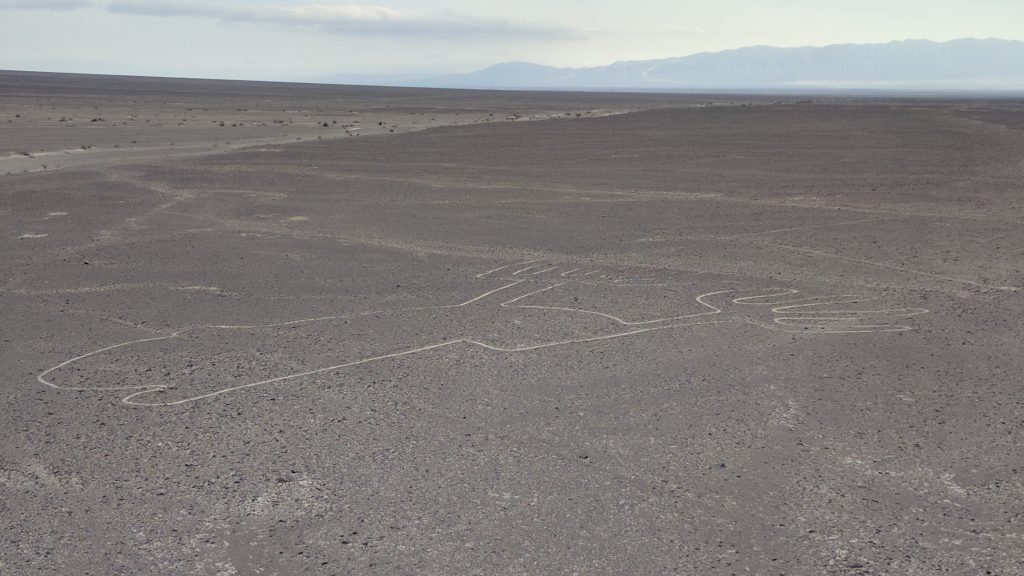
 Each animal or figure represents a God in some fashion which also relates to a time of year for food production. Most academics agree the figures were created to appease the gods to provide a healthy crop year and well being of the people. Despite this theory, mystery will surround these unbelievable remnants for generations to come.
Each animal or figure represents a God in some fashion which also relates to a time of year for food production. Most academics agree the figures were created to appease the gods to provide a healthy crop year and well being of the people. Despite this theory, mystery will surround these unbelievable remnants for generations to come. Continuing on and up, these mountainous roads of Peru also proved to be challenging and a little foreboding.
Continuing on and up, these mountainous roads of Peru also proved to be challenging and a little foreboding. Despite the slow going, we took our time to enjoy the beautiful landscapes and wildlife.
Despite the slow going, we took our time to enjoy the beautiful landscapes and wildlife.  One morning we stopped at a wildlife reserve with a small museum that had exhibits of the local flora and fauna. Two young resident Vicunas (similar to Alpaca, but smaller and wild) lived here and were not shy.
One morning we stopped at a wildlife reserve with a small museum that had exhibits of the local flora and fauna. Two young resident Vicunas (similar to Alpaca, but smaller and wild) lived here and were not shy. The male proceeded to play with Sarah and really wanted to nibble at her pants. The cuteness of his eyes almost provoked us to let him eat them, but instead she ran around letting him chase her which they both enjoyed.
The male proceeded to play with Sarah and really wanted to nibble at her pants. The cuteness of his eyes almost provoked us to let him eat them, but instead she ran around letting him chase her which they both enjoyed.
 As we drove further inland, we almost exceeded 15,000ft in elevation and were astonished to see flamingos feeding in the high altitude lakes.
As we drove further inland, we almost exceeded 15,000ft in elevation and were astonished to see flamingos feeding in the high altitude lakes.  We had discovered from the museum that they are migratory and these lakes are a convenient stop in their epic journey every year. More beautiful high-alpine landscapes full of Llamas and/or Alpacas appeared before us as we ventured onward.
We had discovered from the museum that they are migratory and these lakes are a convenient stop in their epic journey every year. More beautiful high-alpine landscapes full of Llamas and/or Alpacas appeared before us as we ventured onward.
 Along the way, we had a minor pit stop when we encountered a truck rolled over which blocked the entire road. It must have literally happened one minute before we arrived because we were the second car on the scene.
Along the way, we had a minor pit stop when we encountered a truck rolled over which blocked the entire road. It must have literally happened one minute before we arrived because we were the second car on the scene. 
 Fortunately having our home everywhere we go, we ate lunch and read books while we waited for the cleanup. Happy to note that no one was injured in this wreck.
Fortunately having our home everywhere we go, we ate lunch and read books while we waited for the cleanup. Happy to note that no one was injured in this wreck.  After several days of arduous driving, with ruins appearing around every bend, we finally descended into the outskirts of the Sacred Valley and down into a little town named Urubamba.
After several days of arduous driving, with ruins appearing around every bend, we finally descended into the outskirts of the Sacred Valley and down into a little town named Urubamba. From here we decided to make our way straight to Machu Pichu with plans to visit other important sites on our way back through to the Incan capitol of Cusco. Having a set of wheels to visit Machu Pichu is very advantageous.
From here we decided to make our way straight to Machu Pichu with plans to visit other important sites on our way back through to the Incan capitol of Cusco. Having a set of wheels to visit Machu Pichu is very advantageous.  Leaving Urubamba (9500ft) we headed up and up again over another pass at 15,000ft only to descend back down to 4,000ft through stunning beautiful landscapes and multiple eco-systems.
Leaving Urubamba (9500ft) we headed up and up again over another pass at 15,000ft only to descend back down to 4,000ft through stunning beautiful landscapes and multiple eco-systems.  The route was not easy for Koru, but as always he gracefully led us through the winding and steep roads. Arriving to hydro-electrica at the end of a bumpy and narrow road, our hike started along a set of train tracks that take you to the base of the mountain where the ascent to reach Machu Pichu begins.
The route was not easy for Koru, but as always he gracefully led us through the winding and steep roads. Arriving to hydro-electrica at the end of a bumpy and narrow road, our hike started along a set of train tracks that take you to the base of the mountain where the ascent to reach Machu Pichu begins. The vast majority of travelers take a train from Ollantaymbo to Aguas Calientes and then a bus from town to the entrance of the site via a switch-backing road. We opted for the hike less traveled which provided a very enjoyable experience.
The vast majority of travelers take a train from Ollantaymbo to Aguas Calientes and then a bus from town to the entrance of the site via a switch-backing road. We opted for the hike less traveled which provided a very enjoyable experience.  The hike went faster than we anticipated, so we arrived early for our afternoon entry ticket.
The hike went faster than we anticipated, so we arrived early for our afternoon entry ticket. With about an hour to wait, we were amazed at the facilities built up around the newly dubbed ‘Wonder of the World’. Fancy hotel and restaurants resided alongside merchandise vendors and guides were everywhere offering their services which was pretty overwhelming.
With about an hour to wait, we were amazed at the facilities built up around the newly dubbed ‘Wonder of the World’. Fancy hotel and restaurants resided alongside merchandise vendors and guides were everywhere offering their services which was pretty overwhelming.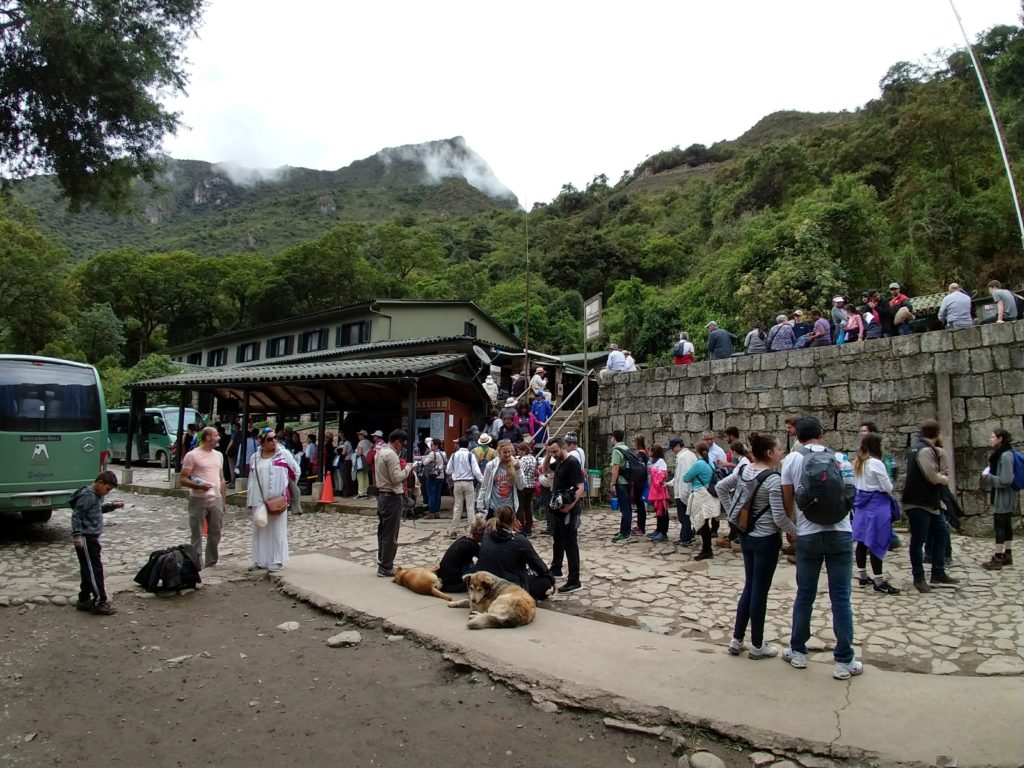 In the meantime we ate a snack and stamped our passports for full proof that we have been here!
In the meantime we ate a snack and stamped our passports for full proof that we have been here!  We were beginning to think that the hype and reputation of the ruins were overblown and too much to handle, but we were very very wrong.
We were beginning to think that the hype and reputation of the ruins were overblown and too much to handle, but we were very very wrong.  Upon entering the sacred site at 1pm, it was as if we’d walked into a different time and place altogether. The feelings received from the top of this mountain are hard to describe in words and hard to show in pictures but here’s our attempt.
Upon entering the sacred site at 1pm, it was as if we’d walked into a different time and place altogether. The feelings received from the top of this mountain are hard to describe in words and hard to show in pictures but here’s our attempt. Despite the ‘gaggle of gringos’ (term we’ve come up with in touristy places with tons of people, of course with ourselves included), we didn’t feel as though it was crowded and were completely blown away by archaeological site.
Despite the ‘gaggle of gringos’ (term we’ve come up with in touristy places with tons of people, of course with ourselves included), we didn’t feel as though it was crowded and were completely blown away by archaeological site.  The extraordinary act of building a small city on a mountain top of such grandeur boggles the mind.
The extraordinary act of building a small city on a mountain top of such grandeur boggles the mind.
 The mysterious stonework and strategic locations of the agricultural terraces, astronomical platforms, and ceremonial sites were equally confusing as they were astonishing.
The mysterious stonework and strategic locations of the agricultural terraces, astronomical platforms, and ceremonial sites were equally confusing as they were astonishing.

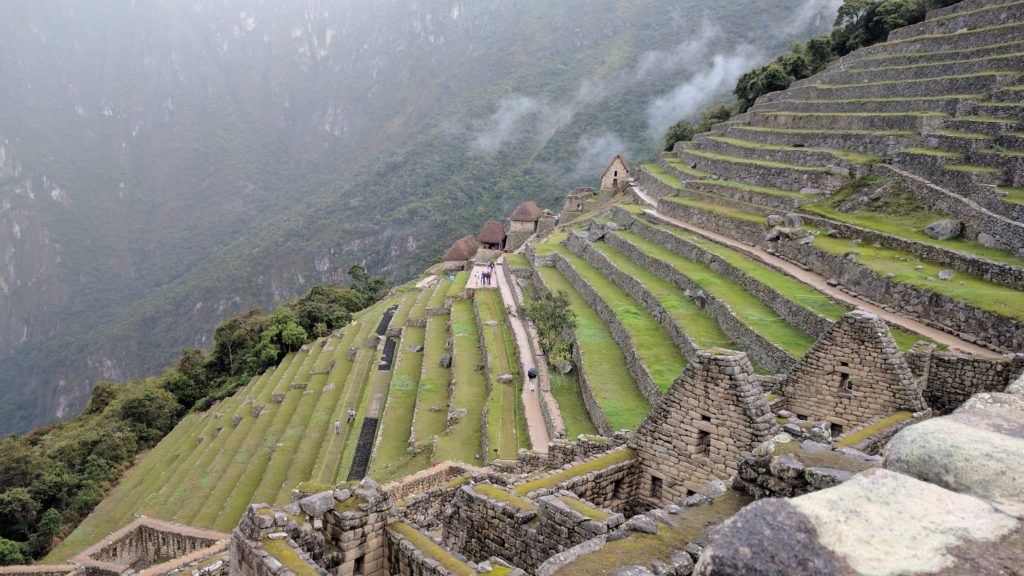 We easily spent our entire allotted time in the site until the setting sun cast glowing light over the mountain.
We easily spent our entire allotted time in the site until the setting sun cast glowing light over the mountain. We walked away from this experience elated and enriched beyond our imagination.
We walked away from this experience elated and enriched beyond our imagination.  All of the effort and stress of the previous days’ drives disappeared as if they never happened. Though we had to walk back down the train tracks to the van in the dark, we felt lucky to have experienced such a special place and slept very easy that night. The next day, before leaving the area we decided to enjoy a quick dip in some hotsprings nearby. It was heavenly.
All of the effort and stress of the previous days’ drives disappeared as if they never happened. Though we had to walk back down the train tracks to the van in the dark, we felt lucky to have experienced such a special place and slept very easy that night. The next day, before leaving the area we decided to enjoy a quick dip in some hotsprings nearby. It was heavenly.  Heading out, we drove back down the crazy road and up and over the pass once again back down into the Sacred Valley.
Heading out, we drove back down the crazy road and up and over the pass once again back down into the Sacred Valley. Driving down the pass, we spotted a friendly woman weaving various handicrafts. Matt practiced his bargaining skills and obtained a beautiful new wool coin pouch.
Driving down the pass, we spotted a friendly woman weaving various handicrafts. Matt practiced his bargaining skills and obtained a beautiful new wool coin pouch.  Rolling into Ollantaytambo, we went back in time yet again surrounded by unimaginable stone ruins.
Rolling into Ollantaytambo, we went back in time yet again surrounded by unimaginable stone ruins.  Safely parking Koru next to another fellow VW overlander, we set out to explore the city and its historical archaeological site.
Safely parking Koru next to another fellow VW overlander, we set out to explore the city and its historical archaeological site.
 The site was beautiful with more shockingly intricate stonework. Here, the Incan’s held off the Spaniards longer than any other city in the empire.
The site was beautiful with more shockingly intricate stonework. Here, the Incan’s held off the Spaniards longer than any other city in the empire.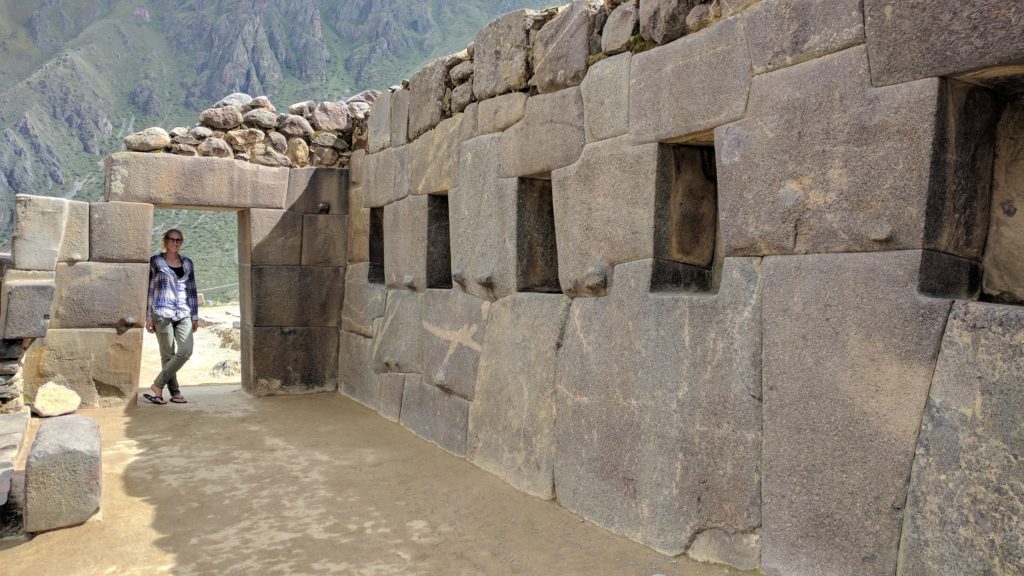
 With their advanced water technology, they were able to flood the entire valley leading into the city on a whim, thus inhibiting the Spaniards to enter and attack.
With their advanced water technology, they were able to flood the entire valley leading into the city on a whim, thus inhibiting the Spaniards to enter and attack. However, the city was eventually overtaken, yet Machu Pichu was never discovered. After another enriching day we headed back to the van and hung out with our fellow travelers and local children who enjoyed playing with us until their parents beckoned them home.
However, the city was eventually overtaken, yet Machu Pichu was never discovered. After another enriching day we headed back to the van and hung out with our fellow travelers and local children who enjoyed playing with us until their parents beckoned them home. Leaving this little gem of a town, we headed towards Cusco. A quick pit stop led us to the famous Salinas de Maras. Maras’ salt evaporation fields provided some spectacular sights and gave us a glimpse into a process of salt extraction that’s been happening here for thousands of years.
Leaving this little gem of a town, we headed towards Cusco. A quick pit stop led us to the famous Salinas de Maras. Maras’ salt evaporation fields provided some spectacular sights and gave us a glimpse into a process of salt extraction that’s been happening here for thousands of years.
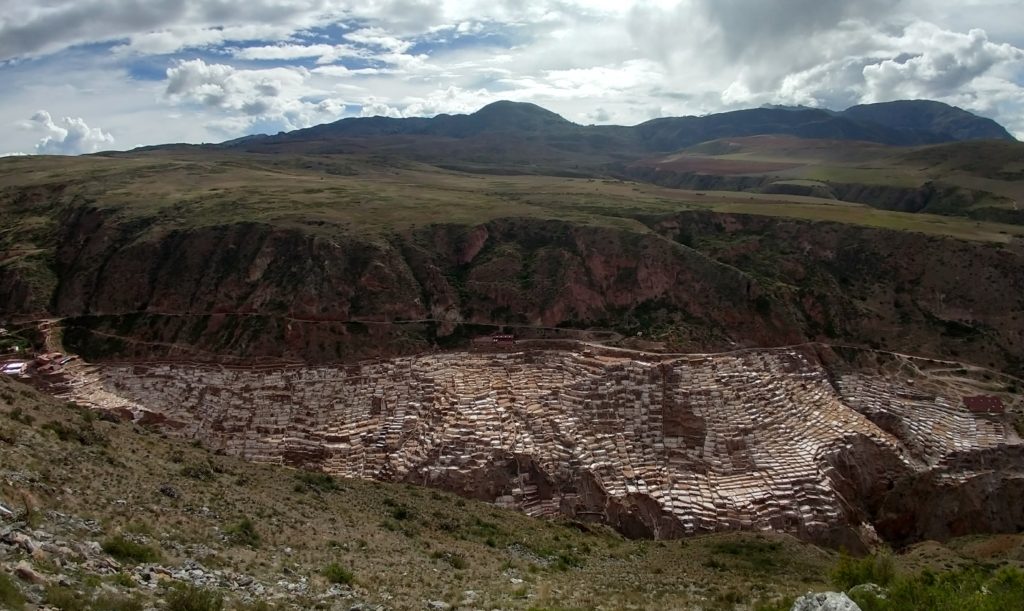 Once in Cusco, we discovered beautiful colonial buildings built atop and intermingled with the ancient stonework of the Incans. It was a city of dualism, where one could find affordable local street food abutted against chic and very expensive bistros and shops where a years paycheck could disappear in mere minutes.
Once in Cusco, we discovered beautiful colonial buildings built atop and intermingled with the ancient stonework of the Incans. It was a city of dualism, where one could find affordable local street food abutted against chic and very expensive bistros and shops where a years paycheck could disappear in mere minutes.  Walking through the streets, we thoroughly enjoyed the diversity encountered around every corner.
Walking through the streets, we thoroughly enjoyed the diversity encountered around every corner.
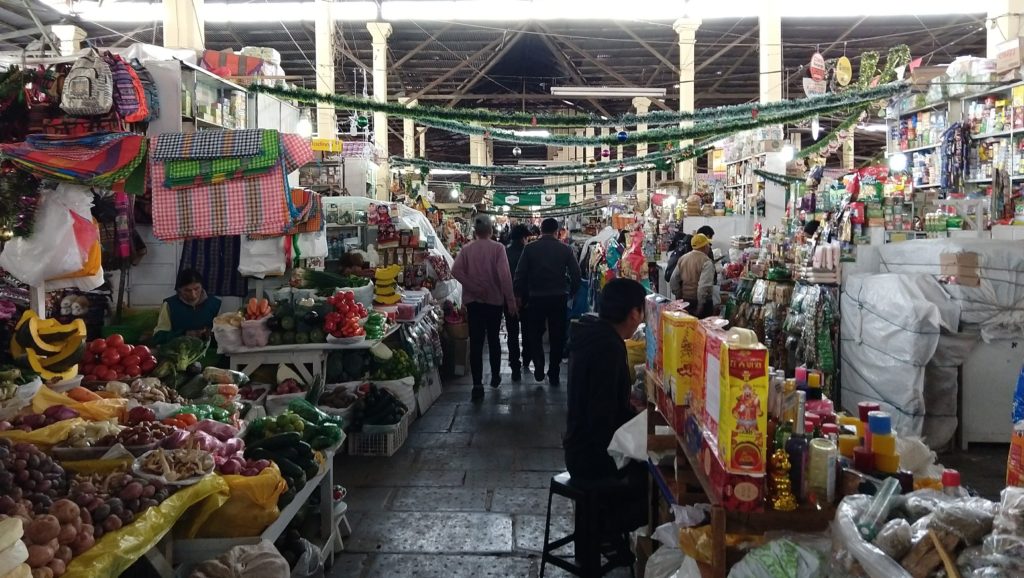 Christmas was upon us, so we retreated into the nearby mountains to get away from the city hustle and bustle with a great view of Cusco to camp and climb with our friends Tim and Andrea.
Christmas was upon us, so we retreated into the nearby mountains to get away from the city hustle and bustle with a great view of Cusco to camp and climb with our friends Tim and Andrea.  We shared a nice Christmas Eve meal together and waited until midnight to witness the extravagant fireworks show that is familiar anywhere in Latin America. We happily witnessed the spectacle from the safety of the mountain.
We shared a nice Christmas Eve meal together and waited until midnight to witness the extravagant fireworks show that is familiar anywhere in Latin America. We happily witnessed the spectacle from the safety of the mountain.  Merry Christmas morning from Koru on the hills above Cusco, Peru (a little delayed)!
Merry Christmas morning from Koru on the hills above Cusco, Peru (a little delayed)!  The time came to continue south, and our goal was to reach Copacabana, Bolivia for New Years. But, we had a few places left to see before the border.
The time came to continue south, and our goal was to reach Copacabana, Bolivia for New Years. But, we had a few places left to see before the border.  First, we headed towards a climbing spot that we’d heard whispers about near the town Pitumarca, and it ended up being one of the best climbing areas we’ve found in Peru.
First, we headed towards a climbing spot that we’d heard whispers about near the town Pitumarca, and it ended up being one of the best climbing areas we’ve found in Peru.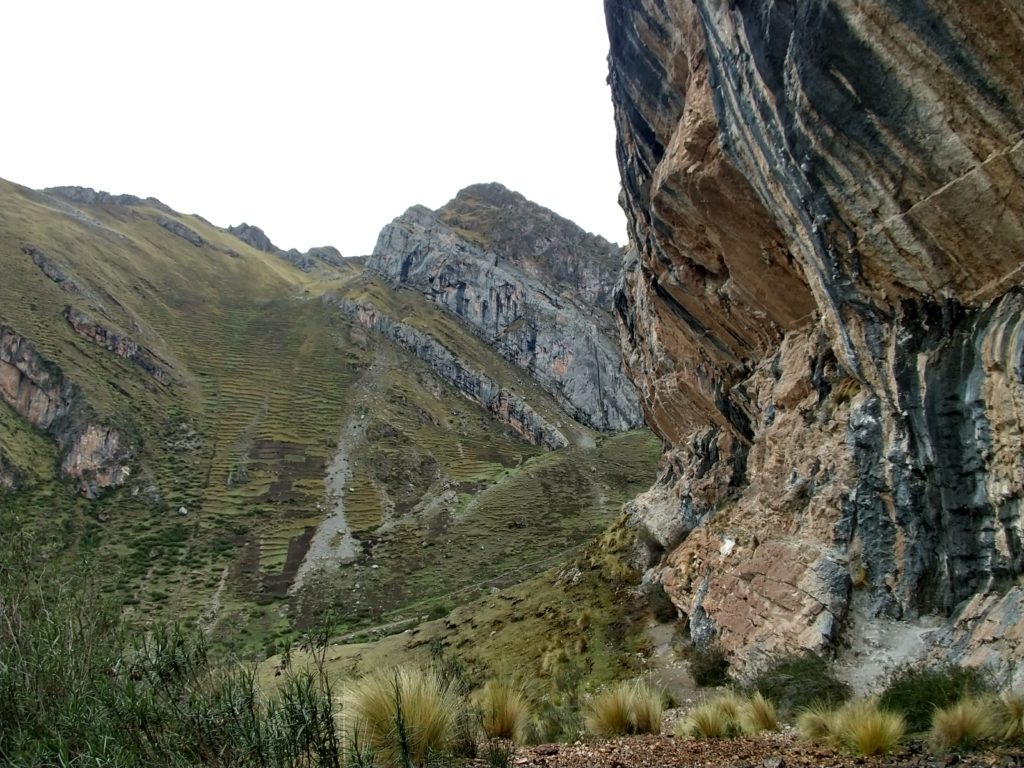 The locals that live there still completely rely on their llama herds and potato farms.
The locals that live there still completely rely on their llama herds and potato farms.  They’ve kindly allowed climbers to come in and develop the rocks, and charge a very small fee to use the area which helps support the community. We had a great time climbing perfect limestone and conversing with the friendly locals with no other climbers around.
They’ve kindly allowed climbers to come in and develop the rocks, and charge a very small fee to use the area which helps support the community. We had a great time climbing perfect limestone and conversing with the friendly locals with no other climbers around.  Next on the list, we joined forces again with Tim and Andrea to visit the newly developed tourist attraction known as Rainbow Mountain, where colorful geologic striations provide a nice view and even better photos (if you have photo shop that is). The writing had been on the wall to move south for a few weeks now with the weather changing rapidly, and this day was no different.
Next on the list, we joined forces again with Tim and Andrea to visit the newly developed tourist attraction known as Rainbow Mountain, where colorful geologic striations provide a nice view and even better photos (if you have photo shop that is). The writing had been on the wall to move south for a few weeks now with the weather changing rapidly, and this day was no different. At the top of the mountain we encountered a lot of snow and very few colorful striations. Laughing and turning the day into a snowball fight, we descended knowing our time in the Peruvian Andes was done, for now.
At the top of the mountain we encountered a lot of snow and very few colorful striations. Laughing and turning the day into a snowball fight, we descended knowing our time in the Peruvian Andes was done, for now. So, like a llama riding a motorcycle, we kept our eyes on the road and pointed our chariot south towards Bolivia.
So, like a llama riding a motorcycle, we kept our eyes on the road and pointed our chariot south towards Bolivia.
14 thoughts on “Mysterious and Sacred Peru”
Wonderful photos, keep safe.
Thanks Aunt Maureen, happy to share with everyone!
Amazing, beautiful photos. I can hardly wait to see all this with my own eyes one day soon!
Karl, we can’t wait to see where your adventure will take you! It is worth every mile!
Beautiful photos. I can’t wait to get there. Heading south from the US on my motorcycle starting July. Can’t wait to ride the Peru mountains and visit all these places.
George, it is an adventure of a lifetime! Enjoy it all and if you need any advise just holler!
Splendid views, especially of the Incan stonework!
Thanks Grandma, it was quite the spectacular sight!
A magical country! Glad that Machu Picchu still has its charm and appeal in spite of the masses that visit it. The mountains are truly fabulous and the roads, oh my!
Thanks Scott, it was a worthwhile unforgettable effort!
Wowee! Excellent edition of Kruisin’ Koru. I’ve never seen a llama on a motorcycle or Macchu Picchu, but you have!
Well written and superb photography. Who is the professional photographer? Your tripod? Do your produce these fabulous blogs on your laptop?
We envy your wealth of experience and computer skills. Are you ever homesick? You two are gonna have to write a book!
Missing you both…
Uncle Steve & Aunt Esther
April 18, 2018
Thanks for the kind comment Steve. We manage it all with smart phones and a not-so-smart laptop. We do get homesick, but we’ll be home before we know it, and will be looking back on all of these great moments. Missing you two as well.
Hola amigos. Maravillosa experiencia en la tierra de los incas, que al mirarlo no puedes creer que hicieron monumentos con tanta precisión…me atrevo a pensar que fue hecha por extraterrestres..impresionante lugar…digno de ser visitado, mi admiración a la cultura inca y el legado que dejaron en el valle sagrado..
Perú..es un país espectacular..es algo difícil de olvidar..de las cosas que más me impactó es las rocas gigantes y perfectamente labradas para construir sus templos…lástima que llegaron los españoles y construyeron sus iglesias sobre los templos indígenas…como koricancha….el templo del oro. En la catedral de Cusco está la primera cruz católica que trajeron los españoles..
Fantástica experiencia..mil gracias por dejarnos saber su hermosa aventura y sus sentimientos ante tanta belleza, y el misterio que encierra el famoso valle sagrado..
Gracias por todo tus comentarios Paulina! Si es una lastima que los españoles destruyeron todo. 🙁 Es una historia triste por todo Latina América. Nos encantan los pueblos y los textiles y es un placer compartir nuestra experiencia contigo! XO